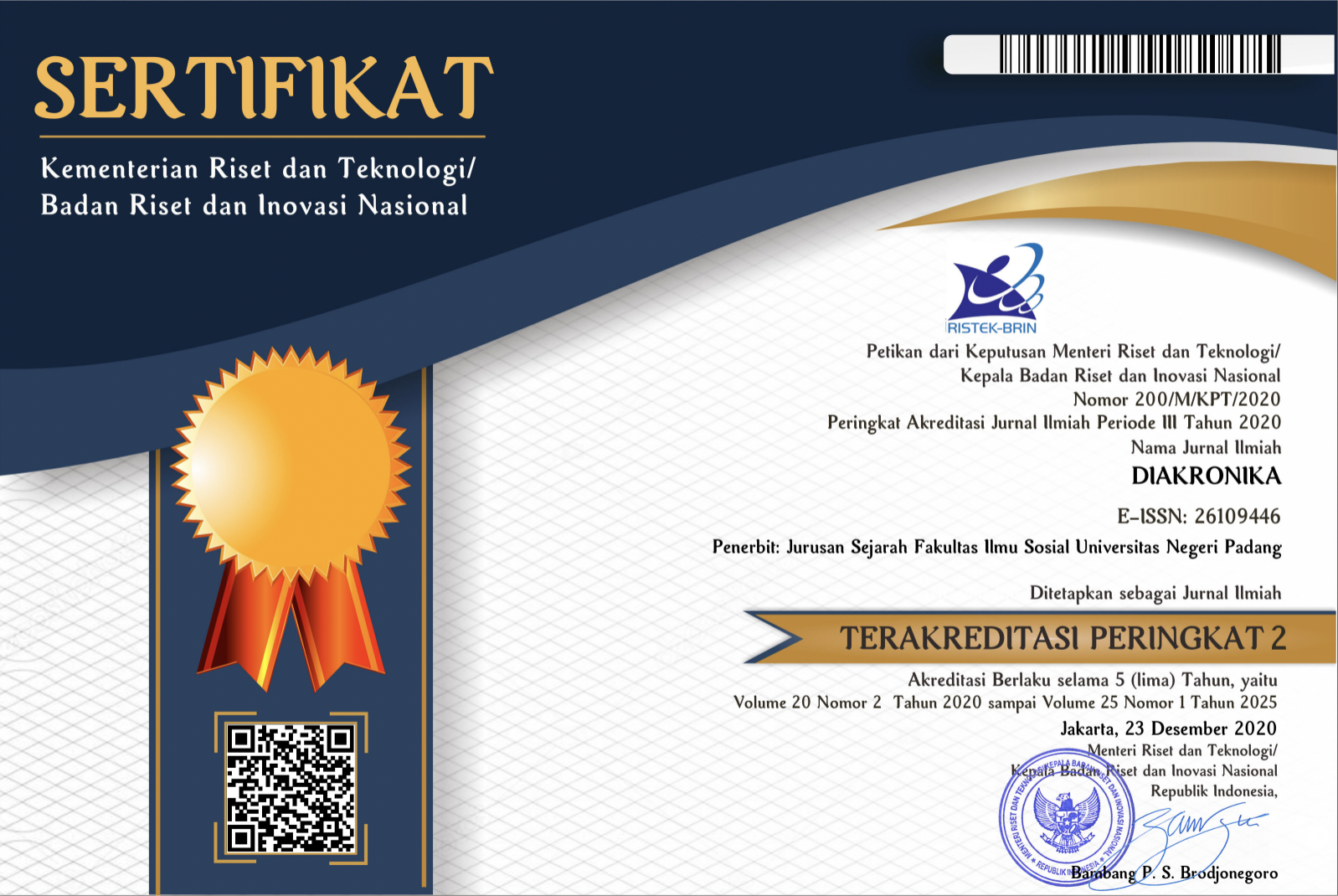Critical Discourse of the Chinese Rebellion in Indonesian History Textbook
Abstract
This study aims to reveal the discourse practices in the narrative of the Chinese Rebellion in the Indonesian History textbook. Having long disappeared from Indonesian historiography, the Chinese-Javanese alliance against the VOC, often called Geger Pacinan (1740-1743), has reappeared in history textbooks. Its presence needs to be studied to understand the discourse practices that are to be conveyed by the narratives that are constructed. This study's subject was the Chinese Rebellion text in the Indonesian History textbook for class XI SMA based on the 2013 Curriculum published by the Ministry of Education and Culture of the Republic of Indonesia in 2017. The Critical Discourse Analysis (CDA) method, according to Teun A. van Dijk, was used to analyze the dimensions of the text, social cognition, and the social context of the narratives that are the research subject. The result is that the report in the text dimension does not present the Chinese role through the history of the event as a whole. In the size of social cognition, it is found that there is a potential to strengthen the practice of discourse, which leads to the marginalization of the Chinese role. The social context dimension has not entirely shifted from the New Order paradigm, which harbored stereotypes against the Chinese. In conclusion, the text of the Chinese Rebellion requires the teacher’s role to make the deconstruction process in learning history meaningful for students, especially in internalizing the value of diversity for national integration.
Downloads
References
Arifin, E. N., Ananta, A., Utami, D. R. W. W., Handayani, N. B., & Pramono, A. (2015). Quantifying Indonesia’s Ethnic Diversity. Asian Population Studies, 11(3), 233–256. https://doi.org/10.1080/17441730.2015.1090692
Arifin, E. N., Hasbullah, M. S., & Pramono, A. (2016). Chinese Indonesians: How Many, Who, and Where? Asian Ethnicity, 1–20. https://doi.org/10.1080/14631369.2016.1227236
Daradjadi. (2013). Geger Pacinan 1740-1743: Persekutuan Tionghoa-Jawa Melawan VOC. Penerbit Buku Kompas.
Davidson, S. J. (2009). Studies of Massive, Collective Violence in Post-Soeharto Indonesia. Critical Asian Studies, 41(2), 329–349. https://doi.org/10.1080/14672710902809450
Dijk, T. A. van. (1994). Discourse and Cognition in Society. In D. Crowley & D. Mitchell (Eds.), Communication Theory Today (pp. 107–126). Stanford University Press.
Djono, & Joebagio, H. (2019). Narration and Discourse of Bhinneka Tunggal Ika in Indonesia Revised History Textbook: A History Didactics Approach. Paramita: Historical Studies Journal, 29(1), 18–27. https://doi.org/10.15294/paramita.v29i1.15311
Eriyanto. (2001). Analisis Wacana: Pengantar Analisis Teks Media. LKiS.
Errington, A., & Bubna-Litic, D. (2015). Management by Textbook: The Role of Textbooks in Developing Critical Thinking. Journal of Management Education, 1–27. https://doi.org/10.1177/1052562915594839
Harjatanaya, T. Y., & Hoon, C.-Y. (2018). Politics of Multicultural Education in Post-Suharto Indonesia: A Study of the Chinese Minority. Compare: A Journal of Comparative and International Education, 1–18. https://doi.org/10.1080/03057925.2018.1493573
Haryatmoko. (2019). Critical Discourse Analysis (Analisis Wacana Kritis): Landasan Teori, Metodologi, dan Penerapan. Rajawali Pers.
Hilburn, J., & Fitchett, P. G. (2012). The New Gateway, An Old Paradox: Immigrants and Involuntary Americans in North Carolina History Textbooks. Theory & Research in Social Education, 40(1), 35–65. https://doi.org/10.1080/00933104.2012.647976
Hung Lau, Kwok, Lam, T., Hon Kam, B., Nkhoma, M., Richardson, J., & Thomas, S. (2017). The Role of Textbook Learning Resources in E-Learning: A Taxonomic Study. Computers & Education, 1–37. https://doi.org/10.1016/j.compedu.2017.11.005
Huntington, A., & Won, C. (2020). What It Means to be Korean: National Identity in North and South Korean Elementary Textbooks 1960–2019. Comparative Education, 1–23. https://doi.org/10.1080/03050068.2020.1812237
Karima, E. M., & Abianza, E. (2023). Pendidikan karakter melalui kisah tokoh sejarah lokal dalam kurikulum merdeka. 58–65. https://doi.org/10.51190/jazirah.v4i1.101
Karima, E. M., Firza, F., & Fitriah, R. (2022). Pengembangan E-Module Interaktif Berbasis Historical Perspective pada Mata Kuliah Sejarah Pendidikan. Indonesian Journal of Social Science Education (IJSSE), 3(2), 151. https://doi.org/10.29300/ijsse.v3i2.5366
Kartodirdjo, S. (1982). Pemikiran dan Perkembangan Historiografi Indonesia: Suatu Alternatif. PT Gramedia.
Kello, K., & Wagner, W. (2017). History Teaching as “Propaganda”? Teachers’ Communication Styles in Post-Transition Societies. In C. Psaltis, M. Carretero, & S. Cehajic-Clancy (Eds.), History Education and Conflict Transformation: Social Psychological Theories, History Teaching, and Reconciliation (pp. 201–230). Palgrave Macmillan. https://doi.org/10.1007/978-3-319-54681-0_8
Kim, H., & Kim, S. K. (2019). Global Convergence or National Identity Making?: The History Textbook Controversy in South Korea 2004-2018. Asia Pacific Journal of Education, 39(2), 252–263. https://doi.org/10.1080/02188791.2019.1621801
Kuntjara, E., & Hoon, C.-Y. (2020). Reassessing Chinese Indonesian Stereotypes: Two Decades After Reformasi. South East Asia Research, 1–18. https://doi.org/10.1080/0967828X.2020.1729664
Kurniawan, H. (2020). Infografik Sejarah dalam Media Sosial: Tren Pendidikan Sejarah Publik. Sejarah Dan Budaya: Jurnal Sejarah, Budaya, Dan Pengajarannya, 14(2), 1–13. https://doi.org/10.17977/um020v14i22020p1-13
Kurniawan, H., Supriatna, N., Mulyana, A., & Yulifar, L. (2023). From Integration to Marginalization: Representation of the Chinese in History Textbooks in Indonesia. Social and Education History, 12(2). https://doi.org/10.17583/hse.11060
Kwartanada, D. (2020). Diingat Sekaligus Dihapuskan: “Cina” dalam Memori Kolektif dan Historiografi Orde Baru. Prisma: Jurnal Pemikiran Sosial Ekonomi, 39(2), 12–33.
Lembong, E. (2011). Istilah “Cina”, “China”, dan “Tionghoa”: Tinjauan Historis dan Masalah Penggunaannya Dewasa Ini. Yayasan Nabil.
Levstik, L. S., & Barton, K. C. (2015). Doing History: Investigating with Children in Elementary and Middle Schools (Fifth). Routledge. https://doi.org/10.4324/9781315818108
Magrini, J. M. (2015). Phenomenology and Curriculum Implementation: Discerning a Living Curriculum through the Analysis of Ted Aoki’s Situational Praxis. Journal of Curriculum Studies, 47(2), 274–299. https://doi.org/10.1080/00220272.2014.1002113
Marshall, S., & Wilson, S. (2012). A Living Curriculum: Conversations About Learning and Teaching. Journal of Technical Education and Training, 4(1–13).
Metzger, S. A., & Harris, L. M. (2018). Introduction: History Education in (and for) a Changing World. In S. A. Metzger & L. M. Harris (Eds.), The Wiley International Handbook of History Teaching and Learning (pp. 1–10). Wiley Blackwell. https://doi.org/10.1002/9781119100812.ch0
Mulyana, A., & Darmiasti. (2009). Historiografi di Indonesia: Dari Magis-Religius Hingga Strukturis. PT Refika Aditama.
Nur’aini, F., Supriatna, N., & Ratmaningsih, N. (2023). Podcasts As a Medium to Foster the Historical Imagination of Students During the Covid-19 Pandemic. Paramita: Historical Studies Journal, 33(1), 129–138. https://doi.org/10.15294/paramita.v33i1.31102
Pavlick, J. (2019). Reproducing Patriotism: An Exploration of Freedom in US History Textbooks. Discourse & Society, 30(5), 482–502. https://doi.org/10.1177/0957926519855787
Pearcy, M. (2014). “We Have Never Known What Death Was Before”: U.S. History Textbooks and the Civil War. The Journal of Social Studies Research, 38, 45–60. https://doi.org/10.1016/j.jssr.2013.12.004
Poesponegoro, M. D., & Notosusanto, N. (Eds). (2008). Sejarah Nasional Indonesia IV: Kemunculan Penjajahan di Indonesia (Edisi Pemutakhiran -cet.2-) (R. P. Soejono & R. Z. Leirissa (Eds.)). Balai Pustaka.
Purwasatria, M. U. (2019). Menguatkan Kembali Nilai Multikulturalisme dan Persatuan Bangsa Melalui Pembelajaran Sejarah. Diakronika, 19(1), 41–49. https://doi.org/10.24036/diakronika/vol19-iss1/79
Pusat Perbukuan. (2019). Panduan Pembekalan Penulis dan Penelaah Buku Teks Pelajaran untuk Program Peminatan SMA/MA Kelas X. Kemendikbud.
Raihani, R. (2017). Education for Multicultural Citizens in Indonesia: Policies and Practices. Compare: A Journal of Comparative and International Education, 1–18. https://doi.org/10.1080/03057925.2017.1399250
Rowland, L., & Barrs, K. (2013). Working with Textbooks: Reconceptualising Student and Teacher Roles in The Classroom. Innovation in Language Learning and Teaching, 7(1), 57–71. https://doi.org/10.1080/17501229.2012.686499
Sardiman, A. M., & Lestariningsih, A. D. (2017). Sejarah Indonesia SMA/MA/SMK/MAK Kelas XI Semester 1. Kementerian Pendidikan dan Kebudayaan.
Segall, A., Trofanenko, B. M., & Schmitt, A. J. (2018). Critical Theory and History Education. In S. A. Metzger & L. M. Harris (Eds.), The Wiley International Handbook of History Teaching and Learning (pp. 283–309). Wiley Blackwell. https://doi.org/10.1002/9781119100812.ch11
Seixas, P. (2000). Schweigen! Die Kinder! or Does Postmodern History Have a Place in the Schools? In P. N. Stearns, P. Seixas, & S. Wineburg (Eds.), Knowing, Teaching, and Learning History: National and International Perspectives (pp. 19–37). NYU Press.
Setiono, B. G. (2008). Tionghoa dalam Pusaran Politik. TransMedia.
Soeharso, R., Sodiq, I., & Wardayanti, R. (2022). Utilization of Little Historian Model for Local History Learning. Paramita: Historical Studies Journal, 32(2), 306–314. https://doi.org/10.15294/paramita.v32i2.29962
Sumaludin, M. M. (2017). Identitas Nasional dalam Buku Teks Pelajaran Sejarah SMA. Jurnal Pendidikan Ilmu Sosial, 26(2), 139–147. https://doi.org/10.17509/jpis.v26i2.8887
Sunny Lie, & Bailey, B. (2016). The power of names in a Chinese Indonesian family’s politics, culture, and identity negotiations. Journal of International and Intercultural Communication, 1–16. https://doi.org/10.1080/17513057.2016.1216577
Supriatna, N. (2007). Konstruksi Pembelajaran Sejarah Kritis. Historia Utama Press.
Suryadinata, L. (2002). Negara dan Etnis Tionghoa: Kasus Indonesia. Pustaka LP3ES Indonesia.
Sutopo, H. B. (2006). Metodologi Penelitian Kualitatif: Dasar Teori dan Terapannya dalam Penelitian (2nd ed.). UNS Press.
Theresia, S., & Dewi, N. (2021). Analisis Cerpen untuk Pembelajaran Sejarah Amerika. Diakronika, 21(1), 29–44. https://doi.org/10.24036/diakronika/vol21-iss1/178
Tricahyono, D., Sariyatun, & Ediyono, S. (2020). Analisis Wacana Kritis Pendidikan Multikultural dan Pendidikan Nilai dalam Buku Teks Sejarah SMA. Socia: Jurnal Ilmu-Ilmu Sosial, 17(1), 1–10. https://doi.org/10.21831/socia.v17i1.32294
Utami, I. W. P., & Widiadi, A. N. (2016). Wacana Bhineka Tunggal Ika dalam Buku Teks Sejarah. Paramita Historical Studies Journal, 26(1), 106–117. https://doi.org/10.15294/paramita.v26i1.5150
Wang, D. (2016). Learning or Becoming: Ideology and National Identity in Textbooks for International Learners of Chinese. Cogent Education, 3(1140361), 1–16. https://doi.org/10.1080/2331186X.2016.1140361
Wu, W. (2020). Politics, Textbooks, and the Boundary of ‘Official Knowledge’: The Case of Liberal Studies in Hong Kong, Pedagogy, Culture & Society. 1–18. https://doi.org/10.1080/14681366.2020.1765846
You, J., Lee, H., & Craig, C. J. (2019). Remaking Textbook Policy: Analysis of National Curriculum Alignment in Korean School Textbooks. Asia Pacific Journal of Education, 1–17. https://doi.org/10.1080/02188791.2019.1572591





